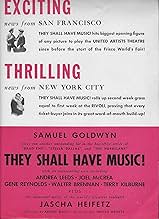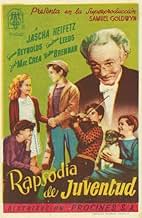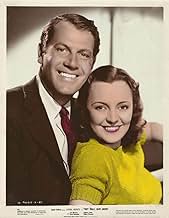VALUTAZIONE IMDb
6,9/10
563
LA TUA VALUTAZIONE
Aggiungi una trama nella tua linguaA boy runs away from home and ends up at a music school for poor children. When the school suffers hard times, he enlists the aid of violinist Heifetz to save the day.A boy runs away from home and ends up at a music school for poor children. When the school suffers hard times, he enlists the aid of violinist Heifetz to save the day.A boy runs away from home and ends up at a music school for poor children. When the school suffers hard times, he enlists the aid of violinist Heifetz to save the day.
- Regia
- Sceneggiatura
- Star
- Candidato a 1 Oscar
- 3 vittorie e 1 candidatura in totale
Gale Sherwood
- Betty
- (as Jacqueline Nash)
Alexander Schoenberg
- Menken
- (as Alexander Schonberg)
Recensioni in evidenza
They Shall Have Music from 1939 stars violinist Jascha Heifetz as himself, Joel McCrea, Gene Reynolds, Walter Brennan, Marjorie Main, and a favorite performer of mine, Zero the Dog. Directed by Archie Mayo.
The basic story concerns a boy (Reynolds) who runs away from home and winds up in a music school for kids. Gifted musically, he attempts to help the school stay open by appealing to Heifetz.
The star, of course, is Heifetz' magnificent playing. Though the film states he plays a Stradivarius, that violin name was thought to be more recognizable to audiences than his actual instrument, a Guarnarius. How wonderful to have Heifetz' gorgeous work on film.
If you like opera, you haven't lived until you've heard nine-year-old Gale Sherwood singing Caro Nome. I know hearing a child squeak out the coloratura was a life-changing experience for me.
In fact, Gale Sherwood grew up to be a lovely soprano who made films, did a nightclub act with Nelson Eddy, performed The Desert Song on tv, and Showboat at the LA Music Center. Then she moved to Florida and retired. She can be heard as an adult on YouTube.
I saw Zero the Dog in High Sierra. His role on that film was a tad more dramatic, but he was a delightful thespian and did a great job in this.
The basic story concerns a boy (Reynolds) who runs away from home and winds up in a music school for kids. Gifted musically, he attempts to help the school stay open by appealing to Heifetz.
The star, of course, is Heifetz' magnificent playing. Though the film states he plays a Stradivarius, that violin name was thought to be more recognizable to audiences than his actual instrument, a Guarnarius. How wonderful to have Heifetz' gorgeous work on film.
If you like opera, you haven't lived until you've heard nine-year-old Gale Sherwood singing Caro Nome. I know hearing a child squeak out the coloratura was a life-changing experience for me.
In fact, Gale Sherwood grew up to be a lovely soprano who made films, did a nightclub act with Nelson Eddy, performed The Desert Song on tv, and Showboat at the LA Music Center. Then she moved to Florida and retired. She can be heard as an adult on YouTube.
I saw Zero the Dog in High Sierra. His role on that film was a tad more dramatic, but he was a delightful thespian and did a great job in this.
For many years, Samuel Goldwin tried to bring his friend Jascha Heifetz to the screen. One evening when Goldwyn and his wife Frances were having dinner with Heifetz and his wife, silent screen star Florence Vidor, Goldwyn proposed that Heifetz star in a movie. After some persuasion, Heifetz agreed, on the condition that his acting be kept to a minimum. And the movie, originally titled "Music School" was born.
The story itself is rather stock: A streetwise boy (Gene Reynolds, who is best known as the producer of "M*A*S*H"), runs away from home and ends up at a financially troubled music school run by Professor Lawson (Walter Brennan). While attempting to raise funds for the school, the boy and some other kids happen across Heifetz at Carnegie Hall. After much ado, Heifetz ends up appearing at the school concert and sponsoring the school.
The story, while predictable,is surprisingly well written, although the film contains several minor gaffes where different scenes were patched together, the most obvious being the young cellist who is sent out of the orchestra room on an errand and is seen sitting in the orchestra a few seconds later.
What is not surprising is how good the acting is. As was customary for studios then, the studio surrounded the inexperienced star with veteran talent: Brennan, Joel McCrea, Andrea Leeds, Porter Hall, Marjorie Main (later of Ma and Pa Kettle fame), Arthur Hohl, Paul Harvey, and a Who's Who of character actors. Actress Diana Lynn and singer/actress Kaye Connor made their (uncredited) debuts in this film, as did longtime Nelson Eddy singing partner Gale Sherwood (as Jacqueline Nash). Child veteran actors Reynolds, Walter Tetley and Terry Kilburn also appear.
Goldwyn hired the Peter Meremblum Symphony, a highly regarded youth orchestra from the Los Angeles Area, to appear in the film. Most of the kids in the orchestra weren't actors, although many were in demand as background players where children were needed. There was no question that they were excellent musicians, as good as professionals (which many of them later became). Many of the kids in the orchestra went on to noteworthy careers: Kaye Connor and Diana Lynn both starred in the theater and movies, Richard Berres was a producer and director, Mitchell Lurie founded a well-known music supply company, Elliott Rapaport went on to be a prominent cardiologist, Lewis Elias was a band leader, Thomas Facey a conductor with different symphonies, Channing Robbins a prominent instructor at the Julliard School, his sister Joyce Robbins an instructor with SUNY Stonybrook. Edwina Pierse(Smith-Johnson) was a teacher and concertmistress and 1st violin with the Long Beach Symphony for over 50 years, Virginia Ellis a teacher and in-demand soloist Mary Louise Zeyen a longtime cellist with the Los Angeles Philharmonic, and many others pursued musical careers with major symphony orchestras and as teachers.
While Heifetz's acting was kept to a minimum, his salary wasn't. He commanded $70,000 for seven weeks. When some scenes had to be re-shot at a later date, he got an additional $50,000 for another four weeks. What thankfully wasn't kept to a minimum was his musical output. Composer Alfred Neumann (who was once a Meremblum Orchestra conductor) handled the scoring. Heifetz performs the "Introductionne and Rondo Capriccioso" by Camille Saint-Saens, his own arrangement of Manuel Ponce's "Estrellita" (with an off-screen Teddy Saidenberg accompanying), Dinicu's devilishly difficult "Hora Staccato" (from a Vitaphone recording, with Emanuel Bay at the piano), an excerpt from Tchaikovsky's "Melodie (Saidenberg at the piano)", an excerpt arranged for violin solo from Tchaikovsky's well-known "Andante Cantabile" from his opus 11 string quartet (played during the opening credits at the beginning of the movie), and the final movement from Felix Mendelssohn's E Minor Violin Concerto. During all of these performances, there are many closeups of Heifetz's performing, including some very close shots of his fingering and bowing, something that would be of value to violinists desiring to study his technique.
The Meremblum orchestra also shines here, performing the arias "Caro Nome" by Verdi and "Casta Diva" by Bellini, (both with Sherwood singing ), an arrangement of the overture from Rossini's "Barber of Seville", a short excerpt from Mozart's "Eine Kleine Nachtmusik", and the previously-mentioned Mendelssohn concerto (with Heifetz). Diana Lynn can be heard in the background of one scene, performing part of Chopin's Nocturne in B-flat Minor, and a five year old Mary Ruth performs Chopin's popular "Minute" Waltz.
All in all, this is an excellent movie. AMC showed this regularly up until early 1993. I haven't seen it on television in recent years, but copies of it are not difficult to obtain. If you have the chance, I highly recommend that you view the movie.
The story itself is rather stock: A streetwise boy (Gene Reynolds, who is best known as the producer of "M*A*S*H"), runs away from home and ends up at a financially troubled music school run by Professor Lawson (Walter Brennan). While attempting to raise funds for the school, the boy and some other kids happen across Heifetz at Carnegie Hall. After much ado, Heifetz ends up appearing at the school concert and sponsoring the school.
The story, while predictable,is surprisingly well written, although the film contains several minor gaffes where different scenes were patched together, the most obvious being the young cellist who is sent out of the orchestra room on an errand and is seen sitting in the orchestra a few seconds later.
What is not surprising is how good the acting is. As was customary for studios then, the studio surrounded the inexperienced star with veteran talent: Brennan, Joel McCrea, Andrea Leeds, Porter Hall, Marjorie Main (later of Ma and Pa Kettle fame), Arthur Hohl, Paul Harvey, and a Who's Who of character actors. Actress Diana Lynn and singer/actress Kaye Connor made their (uncredited) debuts in this film, as did longtime Nelson Eddy singing partner Gale Sherwood (as Jacqueline Nash). Child veteran actors Reynolds, Walter Tetley and Terry Kilburn also appear.
Goldwyn hired the Peter Meremblum Symphony, a highly regarded youth orchestra from the Los Angeles Area, to appear in the film. Most of the kids in the orchestra weren't actors, although many were in demand as background players where children were needed. There was no question that they were excellent musicians, as good as professionals (which many of them later became). Many of the kids in the orchestra went on to noteworthy careers: Kaye Connor and Diana Lynn both starred in the theater and movies, Richard Berres was a producer and director, Mitchell Lurie founded a well-known music supply company, Elliott Rapaport went on to be a prominent cardiologist, Lewis Elias was a band leader, Thomas Facey a conductor with different symphonies, Channing Robbins a prominent instructor at the Julliard School, his sister Joyce Robbins an instructor with SUNY Stonybrook. Edwina Pierse(Smith-Johnson) was a teacher and concertmistress and 1st violin with the Long Beach Symphony for over 50 years, Virginia Ellis a teacher and in-demand soloist Mary Louise Zeyen a longtime cellist with the Los Angeles Philharmonic, and many others pursued musical careers with major symphony orchestras and as teachers.
While Heifetz's acting was kept to a minimum, his salary wasn't. He commanded $70,000 for seven weeks. When some scenes had to be re-shot at a later date, he got an additional $50,000 for another four weeks. What thankfully wasn't kept to a minimum was his musical output. Composer Alfred Neumann (who was once a Meremblum Orchestra conductor) handled the scoring. Heifetz performs the "Introductionne and Rondo Capriccioso" by Camille Saint-Saens, his own arrangement of Manuel Ponce's "Estrellita" (with an off-screen Teddy Saidenberg accompanying), Dinicu's devilishly difficult "Hora Staccato" (from a Vitaphone recording, with Emanuel Bay at the piano), an excerpt from Tchaikovsky's "Melodie (Saidenberg at the piano)", an excerpt arranged for violin solo from Tchaikovsky's well-known "Andante Cantabile" from his opus 11 string quartet (played during the opening credits at the beginning of the movie), and the final movement from Felix Mendelssohn's E Minor Violin Concerto. During all of these performances, there are many closeups of Heifetz's performing, including some very close shots of his fingering and bowing, something that would be of value to violinists desiring to study his technique.
The Meremblum orchestra also shines here, performing the arias "Caro Nome" by Verdi and "Casta Diva" by Bellini, (both with Sherwood singing ), an arrangement of the overture from Rossini's "Barber of Seville", a short excerpt from Mozart's "Eine Kleine Nachtmusik", and the previously-mentioned Mendelssohn concerto (with Heifetz). Diana Lynn can be heard in the background of one scene, performing part of Chopin's Nocturne in B-flat Minor, and a five year old Mary Ruth performs Chopin's popular "Minute" Waltz.
All in all, this is an excellent movie. AMC showed this regularly up until early 1993. I haven't seen it on television in recent years, but copies of it are not difficult to obtain. If you have the chance, I highly recommend that you view the movie.
A bright youngster interested in "serious" music (admittedly a vanishing breed--who'll play the fiddle when no one can play the violin??"--could find this an interesting fiction about street kids and great musical stars. Heifitz was indeed the greatest violinist of his generation and the film gives him a rare on-screen chance to display his technique. The kids, especially Gene Reynolds, are fine and, all in all, the pic is a good example of first-rate studio family fare of the late 30's. It doesn't hit the top of the great '39 list, but it's a nice way for an intelligent family to spend a rainy afternoon with AMC or the Video Store--- good luck at Blockbuster!!!!
I really enjoyed this movie, and I'm not a classical music fan. The story of the tough street kid discovering classical music and changing his ways was great to watch, without being sentimental or too unbelievable, although some details had me scratching my head (Frankie and his dog can live in the basement of the school without any of the students or teachers discovering him? Where did he eat? Bathe? Did he ever get a change of clothes? What did he feed his dog? The owner of the school didn't think it was important to notify the police about finding a missing boy, but let him live in the basement indefinitely? :-) ). But we can let such unrealistic details slide and just enjoy the touching, fun, and slightly suspenseful (for me, anyway) story and wonderfully talented children.
I loved the scene with the mothers standing shoulder to shoulder on the steps barring the policemen from entering the school: I doubt they would get away with that nowadays. And I liked the nice touch about the boy Frankie stole from turning the tables on him (although that never really went anywhere), and Frankie's friends helping him out in the end.
All in all, a great movie for everyone!
I loved the scene with the mothers standing shoulder to shoulder on the steps barring the policemen from entering the school: I doubt they would get away with that nowadays. And I liked the nice touch about the boy Frankie stole from turning the tables on him (although that never really went anywhere), and Frankie's friends helping him out in the end.
All in all, a great movie for everyone!
I caught a clip of this film with Heifetz's performance of Tchaikovsky's Violin Concerto on YouTube - which was phenomenal. Watching the performance from the wings with Andrea Leeds was an actor who looks exactly like Frank McHugh (with mustache), but there's no mention of him in the cast, or of this appearance on his biography page. I assume he was an extra even though he was rather prominent in this single(?), non-speaking appearance in the film. Can anyone confirm if it was him, one way or the other?
Does anyone know if this movie is available on VHS or DVD? I remember seeing it, I believe, on TV, but I'm not certain as to whether I watched a clip of it in a documentary biography of Heifetz, or saw the film, itself.
Does anyone know if this movie is available on VHS or DVD? I remember seeing it, I believe, on TV, but I'm not certain as to whether I watched a clip of it in a documentary biography of Heifetz, or saw the film, itself.
Lo sapevi?
- QuizIn the movie, the newspaper account lists Jascha Heifetz's stolen violin as a Stradivarius. Heifetz used a Guarnarius in the picture and favored that violin in real life, but the producers felt that the name of Stradivarius would be more recognizable.
- BlooperThroughout the picture, the kids in the orchestra are caught looking into the camera or eyeing it sideways, licking their lips, fidgeting, etc.
- Colonne sonoreAndante cantabile
from "String Quartet No.1 in D, Op.11" (1871) (uncredited)
Written by Pyotr Ilyich Tchaikovsky
In the score during the opening credits
Reprised a bit by Gene Reynolds (violin)
I più visti
Accedi per valutare e creare un elenco di titoli salvati per ottenere consigli personalizzati
- How long is They Shall Have Music?Powered by Alexa
Dettagli
- Tempo di esecuzione1 ora 42 minuti
- Colore
- Proporzioni
- 1.37 : 1
Contribuisci a questa pagina
Suggerisci una modifica o aggiungi i contenuti mancanti

Divario superiore
By what name was Armonie di gioventù (1939) officially released in India in English?
Rispondi























